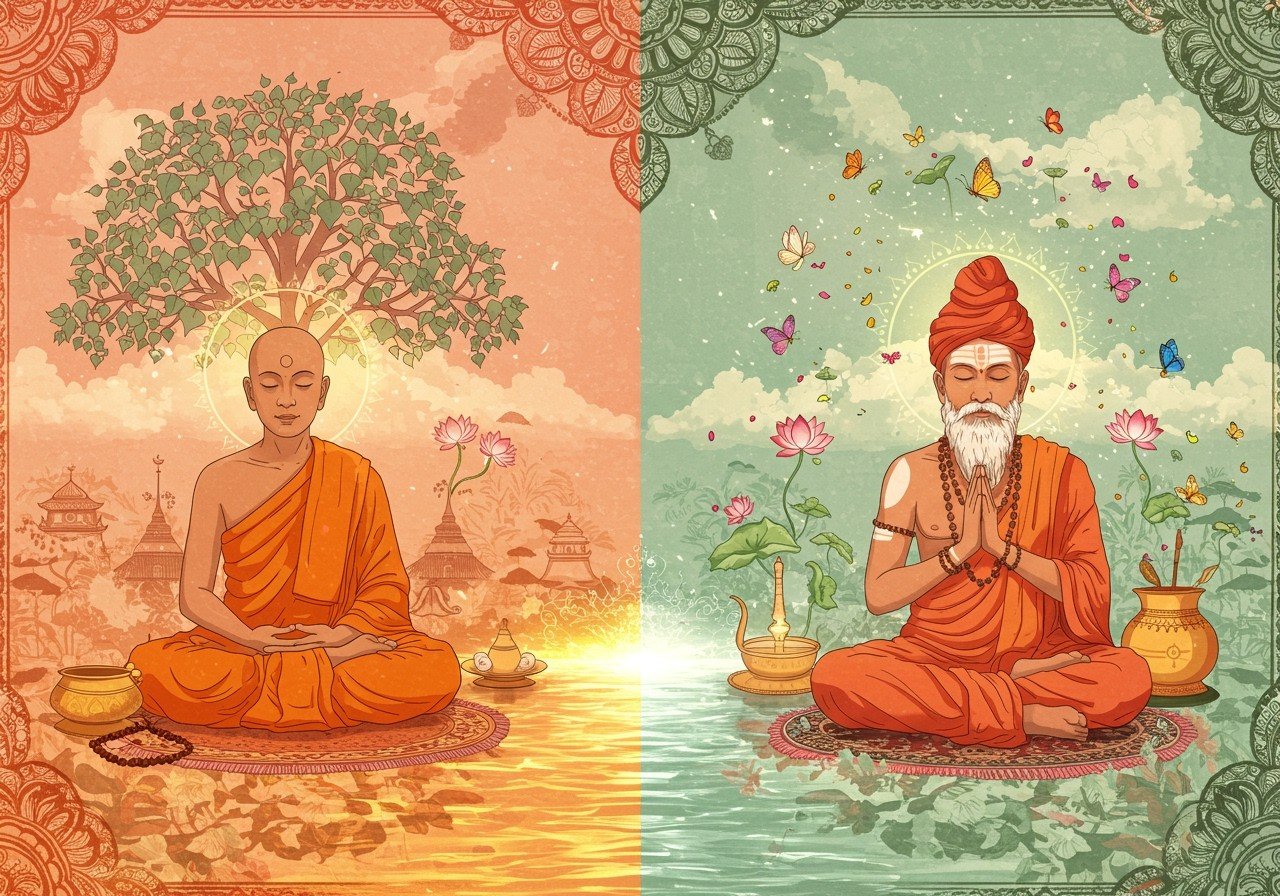
Aparigraha, a concept deeply rooted in ancient Indian philosophies, emphasizes the importance of non-attachment and non-possessiveness. This principle holds significant weight in both Buddhism and Hinduism, each offering unique interpretations and practices. By exploring Aparigraha, we gain valuable insights into the spiritual journeys within these religions and appreciate the rich tapestry of cultural values and practices they embody. This understanding is particularly meaningful for culturally rooted Indians who cherish tradition while embracing the advancements of modern life.
Aparigraha in Hinduism
Within Hinduism, Aparigraha stands as one of the five Yamas (ethical restraints) outlined in Patanjali’s Yoga Sutras. It guides individuals away from the allure of material possessions and the insatiable thirst for more. This principle serves as a compass, directing us toward spiritual growth and a deeper understanding of ourselves.
-
Detachment from Material Wealth: Aparigraha empowers us to loosen the grip of material wealth, recognizing its transient nature. It encourages us to align our actions (karma) with our duty (dharma), finding fulfillment beyond material possessions.
-
Integrating Aparigraha into Daily Life: Aparigraha translates to embracing simplicity and contentment in our daily lives. From the clothes we wear to the food we eat, our choices become a reflection of this principle. It encourages mindful consumption and appreciation for what we have.
-
Wisdom from Ancient Texts: The importance of Aparigraha echoes through ancient Hindu scriptures, highlighting its timeless relevance. These teachings serve as a constant reminder to prioritize spiritual growth over material accumulation, offering guidance for a balanced life.
By embracing Aparigraha, we harmonize our spiritual aspirations with the realities of modern life, finding peace and purpose in our journey.
Aparigraha in Buddhism
In the Buddhist tradition, Aparigraha takes on the essence of letting go. It’s about releasing the tight hold of desires and attachments, recognizing their impermanent nature. This principle forms a cornerstone in the path towards enlightenment, freeing us from the cycle of suffering.
-
Embracing Impermanence (Anicca): The Buddhist concept of Anicca emphasizes the ever-changing nature of reality. Understanding this impermanence allows us to detach from fleeting experiences and possessions, paving the way for true liberation.
-
The Four Noble Truths and Aparigraha: Aparigraha is interwoven with the Four Noble Truths, helping us recognize the root of suffering and guiding us toward the path of peace and liberation. It emphasizes that clinging to desires is a primary source of suffering.
-
The Eightfold Path: The Eightfold Path, a core teaching in Buddhism, includes Right Intention and Right Livelihood. Both aspects are deeply connected to living without attachment, encouraging ethical and mindful actions in all aspects of life.
-
Monastic Life and Simplicity: Monks exemplify Aparigraha through their vows of poverty. Their mindful existence, with minimal possessions, emphasizes the focus on spiritual development over material wealth.
While both Theravada and Mahayana Buddhism hold Aparigraha in high regard, their practical applications differ slightly. Theravada Buddhism primarily focuses on individual enlightenment, whereas Mahayana Buddhism extends this pursuit to encompass the liberation of all beings.
Comparing Aparigraha in Hinduism and Buddhism
Although both Hinduism and Buddhism share the principle of Aparigraha, their interpretations and applications vary based on their core philosophies. Hinduism connects Aparigraha to the concept of the self (atman) and liberation (moksha), while Buddhism links it to the concept of non-self (anatta) and Nirvana.
-
Cultural Context: The unique cultural contexts in which these religions developed have shaped their understanding and practice of Aparigraha. These nuances reflect the diverse expressions of spiritual wisdom within Indian traditions.
-
Convergence of Paths: Despite their differences, both Hinduism and Buddhism converge on the importance of simplicity and non-attachment as pathways to spiritual growth and liberation from suffering. This shared value highlights the interconnectedness of these ancient traditions.
Aparigraha in the Modern World
In today’s consumer-driven society, Aparigraha offers a powerful antidote to the pervasive nature of materialism. It encourages us to embrace minimalism and make conscious choices about our consumption.
-
Mindful Consumption: Aparigraha inspires us to be more aware of our purchasing habits, questioning our needs versus our wants. It’s about making intentional choices that align with our values and minimize our impact on the environment.
-
Yoga and Mindfulness Practices: Modern yoga and mindfulness practices often integrate the principles of Aparigraha. These practices promote mental well-being and encourage a deeper connection with ourselves, free from the distractions of material desires. You can purchase a sacred thread for your spiritual practices from Poojn.in.
-
Technology’s Double-Edged Sword: Online platforms can present both opportunities and challenges in practicing non-attachment. While they offer access to information and resources, they can also fuel consumerism and create new forms of attachment. Navigating this digital landscape mindfully is crucial.
Cultural Significance of Aparigraha in India
For Indians, Aparigraha extends beyond the realm of personal spirituality, influencing social norms and values. It shapes our interactions and relationships within the community.
-
Hospitality and Charity as Expressions of Non-Attachment: The cultural values of hospitality and charity are deeply rooted in the principle of non-attachment. Sharing what we have with others reflects a detachment from material possessions and a recognition of our interconnectedness.
-
Aparigraha in Literature and Art: Stories and artwork often depict Aparigraha as a moral compass. These cultural expressions reinforce the importance of non-attachment and its positive impact on individuals and society. Consider adorning your space with a handcrafted wooden mask from Poojn.in, a symbol of tradition and cultural richness.
-
Navigating Globalization’s Influence: While modern global influences may sometimes clash with traditional views, they also provide new lenses through which to understand and practice Aparigraha in a changing world. It’s a dynamic interplay between tradition and modernity.
Aparigraha remains a guiding light, illuminating the path towards a balanced and meaningful life. It helps us navigate the complexities of modern life while staying connected to our cultural roots and spiritual heritage. It’s a journey of continuous learning and adaptation, where we strive to live with intention, gratitude, and a deep appreciation for the present moment. Read about other spiritual concepts like mindfulness meditation here.
How Poojn.in Supports Your Spiritual Journey
Poojn.in understands the importance of mindful practices and offers a thoughtful selection of puja essentials that align with the principles of Aparigraha. Explore our collection of authentic items, carefully chosen to enhance your spiritual practices without encouraging excessive accumulation. We are committed to providing high-quality products at transparent prices, making your spiritual journey more accessible and meaningful. Discover a range of items, from simple diyas to pure cotton asanas, all designed to support your practice of Aparigraha.
Explore our curated collection:
- Simple brass and wooden offering bowls
- Basic meditation cushions
- Plain prayer beads for mindful practice
- Minimalist incense holders
- Simple copper puja items
- Basic diya sets
- Essential puja thalis without excessive ornamentation
- Pure cotton asanas for meditation
Visit www.poojn.in today to discover how we can support your spiritual journey with authenticity and reverence. You can also explore our Bengali version of the Bhagavad Gita here and enhance your spiritual understanding. Use Maha Tirtha Gold Sindoor to elevate your spiritual practices and embrace the auspiciousness of tradition.
Embracing Aparigraha Today
Aparigraha, the practice of non-attachment, continues to be a relevant guide, bridging the wisdom of our ancestors with the realities of our modern lives. In both Buddhism and Hinduism, it teaches the profound value of living simply and mindfully. In a world saturated with material temptations and distractions, Aparigraha reminds us that true contentment lies not in what we possess, but in the richness of our inner world. It gently nudges us toward spiritual growth and a deeper connection with ourselves.
By embracing Aparigraha, we honor our traditions while finding balance in our fast-paced lives. Whether through conscious consumerism, mindful living, or adopting a minimalist lifestyle, we can weave this timeless principle into the fabric of our daily routines. It empowers us to let go of what we don’t truly need, allowing us to focus on what truly matters – our relationships, our values, and our spiritual well-being.
Embracing Aparigraha is more than just a practice; it is a way of living that enriches our lives and the lives of those around us. It’s a journey of simplicity, where every step brings us closer to inner peace and a sense of fulfillment. As we continue to explore and adapt these teachings, we discover that Aparigraha is not just about having less, but about living more fully.
Frequently Asked Questions about Aparigraha
What does Aparigraha mean in Hinduism? In Hinduism, Aparigraha signifies non-possessiveness and non-greed. It guides individuals towards contentment and detachment from material wealth, encouraging a focus on spiritual development.
How is Aparigraha practiced in Buddhism? Buddhist teachings emphasize Aparigraha as the practice of letting go of attachments and desires. This involves recognizing the impermanent nature of all things and cultivating a mindset free from clinging.
Why is Aparigraha significant in Hinduism? Aparigraha holds a crucial place in Hinduism as it fosters simplicity and contentment. It helps individuals detach from material possessions and focus on spiritual growth and self-realization.
Can Aparigraha contribute to a happier life? Yes, by reducing stress and anxiety associated with material possessions, Aparigraha can pave the way for a more fulfilling and joyful existence. It encourages living in the present moment with gratitude.
How do Buddhism and Hinduism differ in their understanding of Aparigraha? While both traditions value Aparigraha, their emphasis varies. Hinduism seeks to balance material needs with spiritual growth, whereas Buddhism prioritizes the complete relinquishment of desires for enlightenment.
What are some practical ways to incorporate Aparigraha into daily life? Decluttering your living space, donating unused items, making mindful purchasing decisions, and prioritizing experiences over possessions are all practical ways to embrace Aparigraha.
Does Aparigraha necessitate giving up all possessions? No, Aparigraha doesn’t require complete renunciation of possessions. It emphasizes having only what’s essential and avoiding attachment to material things.
Is the concept of Aparigraha still relevant in modern times? Absolutely! Aparigraha is highly relevant today, promoting sustainable living, mindful consumption, and a deeper connection with oneself and the world around us.


